When patients need care, their first stop is rarely the waiting room. Instead, it’s Google.
Whether someone is searching for “pediatric urgent care near me,” “best cardiologist in Dallas,” or simply trying to understand their symptoms, the journey often begins online.
If your healthcare practice doesn’t show up in those search results, you’re effectively invisible to the people who need you most.
That’s where healthcare SEO (search engine optimization) comes in.
Unlike general SEO, healthcare SEO has higher stakes: your content falls under Google’s “Your Money or Your Life” (YMYL) category, meaning accuracy, trust, and authority are just as important as rankings.
Patients aren’t just looking for answers: they’re looking for reassurance and credible providers they can trust with their health.
In this guide, you’ll learn how to build a healthcare SEO strategy that not only improves your visibility in search engines, but also strengthens patient trust, drives more appointments, and keeps your organization competitive in an increasingly digital-first healthcare world.
Importance of Healthcare SEO
Healthcare SEO is essential because it boosts visibility, builds patient trust, and keeps providers competitive in a crowded digital market. Here’s why it’s essential for any practice, hospital, or clinic:
- Most patients begin their journey online: Whether they’re looking for a provider, researching treatment options, or searching “urgent care near me,” the path to care often starts with Google. If you’re not visible, you’re missing out on new patients.
- Trust is everything in healthcare: Google’s Your Money or Your Life (YMYL) standards mean your site must meet higher expectations for accuracy, expertise, and transparency. Ranking well requires not just keywords, but also proven credibility.
- Quality content protects your reputation: Outdated or inaccurate medical information can harm patient trust and even create legal or compliance risks. Optimized, medically sound content builds confidence in your expertise.
- SEO drives long-term, cost-effective growth: Unlike paid ads that stop when you stop spending, SEO compounds over time. High-quality pages, strong local visibility, and authority signals can generate patients for years.
- Competition is fierce: From large hospital systems to telehealth startups, every provider is fighting for visibility. SEO ensures your organization doesn’t get buried under competitors.
In short, healthcare SEO is more than a way to “rank higher”—it’s how providers build authority, attract patients at critical decision moments, and stay competitive.
How to Get Started with Healthcare SEO
1. Understand How Patients Search for Care
Before you optimize a single page, you need to understand how patients actually look for healthcare services online. Their search journey is rarely a straight line—it usually moves through different stages:
- Symptom stage: Patients search for information about symptoms (e.g., “chest pain at night,” “rash on arm itchy”).
- Provider stage: Once they decide they need care, they search for options (e.g., “cardiologist near me,” “dermatologist in Dallas”).
- Decision stage: Patients compare providers by location, reviews, insurance coverage, and specialties (e.g., “best pediatric urgent care open now”).

Start by using keyword research tools such as Semrush or Ahrefs to uncover the exact phrases patients type at each stage of their journey.
Once you’ve collected your keywords, group them into clusters that align with patient intent:
- Informational: Questions about symptoms or conditions
- Navigational: Searches for specific providers or clinics
- Transactional: Queries from patients ready to book an appointment
As you build out these clusters, don’t overlook local search modifiers like “near me,” “open now,” or “[city] urgent care,” which tend to be some of the highest-converting queries in SEO for healthcare.
By mapping your content to the full patient journey, you ensure your practice is visible at every step—from the first symptom search to the final booking decision.
2. Optimize for Google and Answer Engines (AI & Voice)
Search is changing. Patients no longer just scroll through blue links—they’re getting instant answers from Google’s featured snippets, AI-powered overviews, and even voice assistants like Siri or Alexa.
If your healthcare content isn’t optimized for these formats, you risk being left out of the conversation entirely.
To increase visibility in both traditional search and AI-driven results, structure your content in a Q&A format.
Breaking down complex health topics into simple, scannable questions and answers (e.g., “What are the early signs of diabetes?”) makes it easier to capture featured snippets and appear in AI-powered summaries.
Complement this with schema markup: adding FAQ, How-To, and Review schema helps Google and AI systems understand your content more clearly, especially for services, reviews, and provider details.
It’s also important to target conversational queries, since people speak differently than they type. Optimizing for natural, spoken questions like “Where’s the nearest urgent care that takes Blue Cross?” will help you capture voice searches.
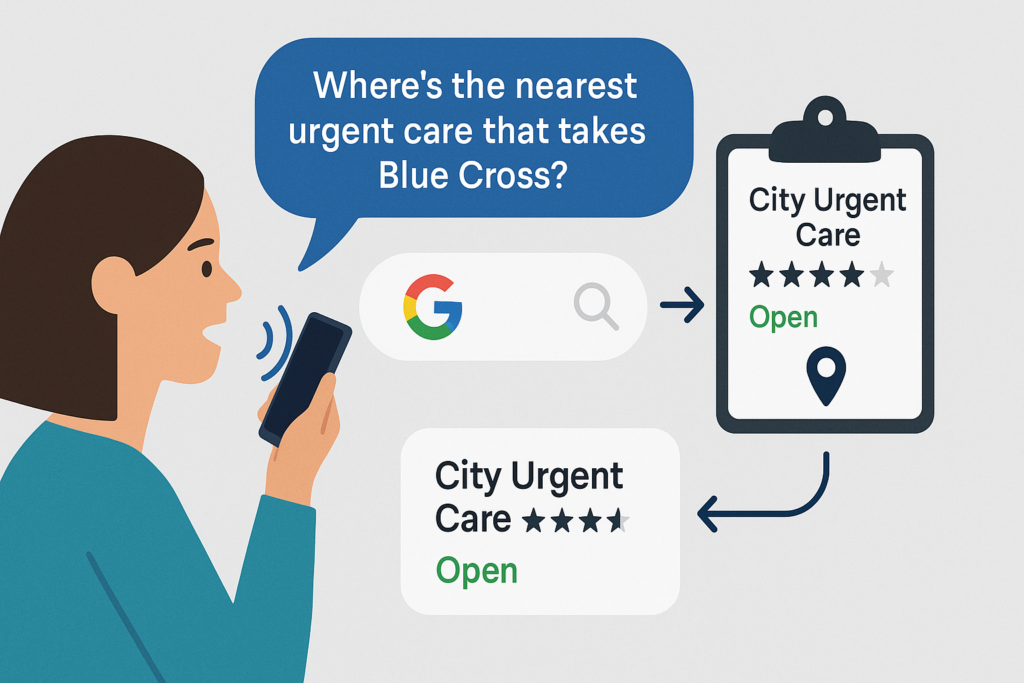
Finally, optimize your content for Google’s AI Overviews by focusing on concise, authoritative answers that AI can surface directly. This means offering clear definitions, easy-to-scan bullet points, and strong trust signals like author bios and citations.
By doing this, your practice will remain visible across both current and emerging search platforms, ensuring patients can find you no matter how they ask for care.
3. Build Patient Trust with Content That Shows E-E-A-T
In healthcare, visibility isn’t enough—patients (and Google) need proof that your information is trustworthy. That’s where E-E-A-T comes in: Experience, Expertise, Authoritativeness, and Trustworthiness.
For medical content, demonstrating E-E-A-T isn’t optional; it’s required.
Here’s how to do it:
- Show author credentials: Add bylines with medical degrees, professional titles, and links to provider bios. Patients and search engines both want to know who wrote or reviewed your content.
- Cite authoritative sources: Reference peer-reviewed studies, government health sites (CDC, NIH, WHO), or accredited medical organizations. This reinforces accuracy.
- Keep content updated: Medical guidelines change, so make sure your content reflects the latest standards of care. Add “last reviewed” or “last updated” dates for transparency.
- Write in plain language: Avoid overly technical terms that confuse patients. Use clear, empathetic explanations that balance accuracy with accessibility.
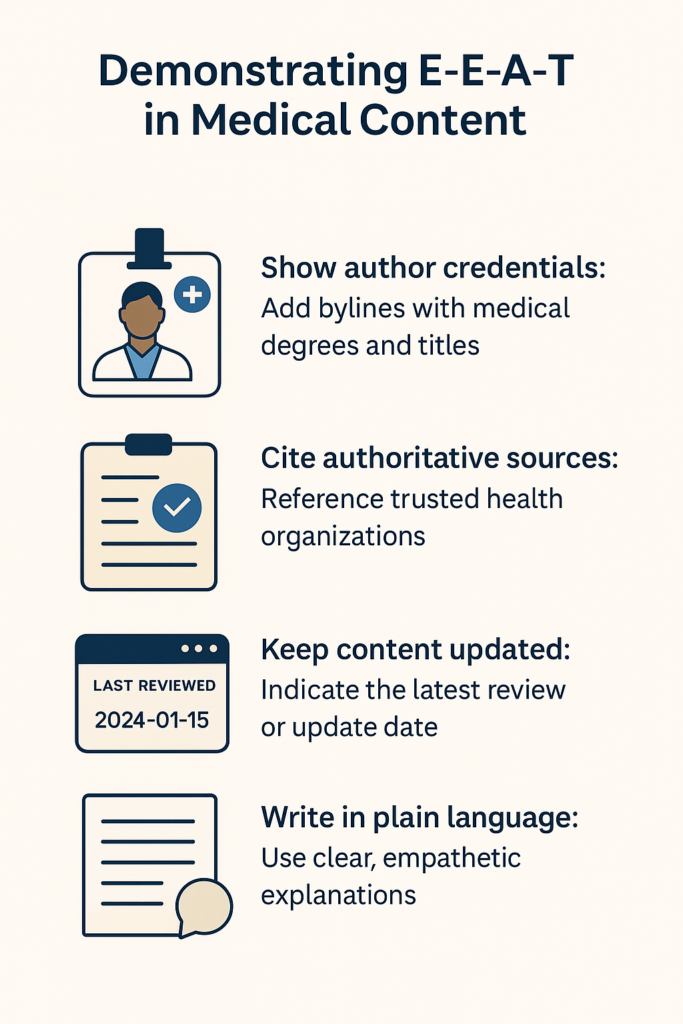
When patients see that your content is created or reviewed by experts, backed by credible sources, and written in a way they can understand, they’re more likely to choose your practice. And Google is more likely to reward your site with higher rankings.
4. Fix Technical SEO Issues That Block Visibility
Even the best content won’t rank if search engines can’t crawl, index, and load your site properly. Technical SEO is the foundation that ensures your healthcare website is accessible, fast, and secure for both patients and Google.
Here’s what you can do to improve your site’s technical SEO:
- Speed up your site: Patients won’t wait for slow pages. Use tools like Google PageSpeed Insights or GTmetrix to find and fix speed issues.
- Make your site mobile-first: Most healthcare searches happen on mobile devices. Ensure your design is responsive, text is easy to read, and buttons and forms are easy to use on small screens.
- Secure your website: Implement HTTPS with a valid SSL certificate. For healthcare sites handling sensitive information, this isn’t optional—it’s critical for patient trust and compliance.
- Simplify your site structure: Organize content into logical categories (e.g., Services → Pediatrics → Immunizations). Use clear navigation and internal links so patients and search engines can find pages easily.
- Fix crawl errors: Regularly audit your site for broken links, duplicate pages, and missing metadata. Submit an XML sitemap in Google Search Console to ensure full indexing.
Think of technical SEO as the digital infrastructure of your practice. Without it, even great content and strong branding will struggle to reach patients.
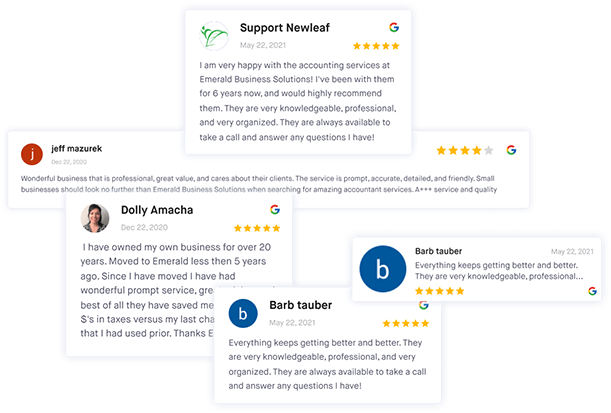
Improve your online reputation
Use ReviewsOnMyWebsite to manage and improve your practice's online reputation with ease.
5. Dominate Local SEO to Capture Nearby Patients
Most patients want care close to home, making local SEO for healthcare one of the most powerful levers for growth.
If your practice doesn’t appear in the local map pack, you’re likely losing patients to competitors who do.
Here’s how to improve your local SEO:
Claim and Optimize Your Google Business Profile
Your Google Business Profile (GBP) is often the first thing patients see when searching for care. Make sure every field is complete, from business categories and services to office hours, accepted insurance, and photos of your facility.
Regularly update your GBP with posts about seasonal health tips, new services, or announcements to keep it active.
An optimized profile not only improves your chances of appearing in local searches but also provides patients with the information they need to choose you over competitors.
Keep NAP Details Consistent Across All Directories
Search engines use your Name, Address, and Phone number (NAP) to verify your practice’s legitimacy.
Even small inconsistencies (like “St.” vs. “Street” or different phone formats) can create confusion and hurt your rankings.
Audit your listings across Google, Yelp, Healthgrades, insurance directories, and your own website to make sure they match exactly. This consistency helps Google trust your business data and improves your chances of ranking in local results.
Create Local Landing Pages for Each Location or Specialty
If you operate in multiple cities or offer specialized services, build dedicated landing pages that combine your service and location keywords (e.g., “Pediatric Dentistry in Boston”).
These pages should include unique content tailored to that area: directions, embedded maps, local testimonials, and information about the providers at that location.
Avoid copying and pasting the same text across pages—duplicate content won’t rank well.
Use Local Schema Markup to Strengthen Your Listings
Schema markup is structured data that tells search engines exactly what your business is, where it’s located, and what services you provide.
For healthcare practices, this can include details like medical specialties, accepted insurance plans, and office hours.
Adding local schema helps your site appear in rich results, such as knowledge panels and local packs. This extra layer of clarity signals to Google that your practice is relevant for local patients and increases your visibility in competitive markets.
6. Manage Online Reviews and Reputation
In healthcare, reviews aren’t just about reputation—they directly impact your search visibility and patient acquisition.
A steady flow of positive reviews helps your practice rank higher in local results while also reassuring patients that they can trust you with their care.
Managing reviews well can be the difference between a patient booking with you or choosing a competitor.
Encourage Patients to Leave Reviews on Key Platforms
After an appointment, politely ask satisfied patients to share their experience online. The most important platforms include Google, Healthgrades, and Yelp, but don’t overlook specialty-specific directories or insurance networks.
To increase participation, make the process as easy as possible: send a follow-up email with direct links or provide a QR code in your office.
Pro tip: You can use ReviewsOnMyWebsite’s tools to generate more reviews for your medical practice on autopilot. For example, by setting up automated email and SMS review request campaigns that ensure every patient gets asked to leave a review.
A steady stream of authentic, compliant reviews signals to both patients and search engines that your practice is trusted and active.

Improve your online reputation
Use ReviewsOnMyWebsite to manage and improve your practice's online reputation with ease.
Respond Quickly and Professionally to Every Review
How you respond to reviews—positive or negative—says a lot about your practice.
Thanking patients for positive reviews shows appreciation, while empathetic responses to negative ones demonstrate accountability.
If someone posts a negative review, acknowledge the concern and invite them to resolve the issue offline rather than debating in public. According to our research, providing a thoughtful response builds trust for 78.3% of consumers.
Importantly, keep every response HIPAA-compliant. Never confirm that someone is a patient or mention details about their treatment.
Stick to general language such as, “We’re sorry to hear about your experience. Please contact our office directly so we can address your concerns.”
This protects patient privacy while still showing that you care and take feedback seriously.
Pro tip: You can use ReviewsOnMyWebsite to read and reply to all your practice’s reviews from one place. There’s even an option to generate personalized replies using AI.

Showcase Testimonials Strategically on Your Website
Reviews shouldn’t only live on third-party platforms. Feature them on your own website as well.
Highlight testimonials on your homepage, service pages, or a dedicated “Patient Stories” section to build credibility with new visitors.
This is very easy to do using ReviewsOnMyWebsite’s customizable review widget. Simply add a piece of code to your site and you’re ready to go.
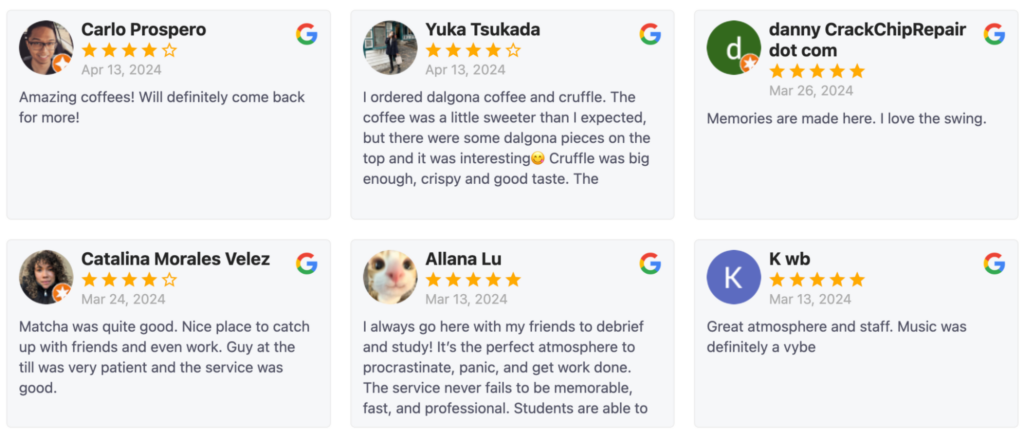
To remain compliant, obtain written consent before publishing any patient feedback on your site.
Featuring verified patient voices where prospects make decisions provides powerful social proof while maintaining both HIPAA compliance and patient trust.
7. Ensure Compliance and Accessibility from the Start
SEO for healthcare companies isn’t only about traffic—it’s about protecting privacy and ensuring accessibility.
Here’s how to do just that:
- Stay HIPAA-compliant across your website: Any page that collects patient information—such as forms, portals, or appointment requests—must be secured and HIPAA-compliant. This means using encryption (HTTPS), secure hosting, and clear privacy policies.
- Meet accessibility standards for all patients: Follow WCAG 2.1 guidelines to make your site usable for people with disabilities. This includes proper text contrast, alt text for images, descriptive link text, and screen-reader-friendly formatting.
- Write policies that build transparency and trust: Patients want to know how their information is protected. Publish clear, easy-to-read privacy and data use policies. Transparency not only builds trust but also signals to search engines that your site is safe and reliable.
8. Earn High-Authority Backlinks
Backlinks (links from other sites to your site) act as votes of confidence from other websites, signaling to Google that your content is trustworthy and authoritative.
In healthcare, where credibility is everything, earning links from the right sources can significantly boost your rankings.
Here are a few effective methods for generating backlinks to your practice’s website:
- Partner with medical associations, universities, and nonprofits: Collaborating with reputable organizations not only builds your authority but also creates natural opportunities for backlinks. For example, sponsoring a local health event or contributing expert commentary for a medical association can earn you a mention (and link) on their site.
- Publish expert guest content on healthcare websites: Many health publications and blogs accept guest contributions from industry experts. By providing valuable, medically accurate content, you can earn backlinks while positioning your providers as thought leaders.
- Create shareable resources that others will link to: Original research, patient education guides, and infographics can serve as linkable assets. For example, a well-designed “Complete Guide to Diabetes Management” or a local health statistics report could attract citations from other healthcare organizations, news outlets, or academic sources.
9. Balance SEO With Patient Trust to Avoid Pitfalls
Optimizing for search visibility is important, but in healthcare, pushing too hard on SEO tactics can backfire. Patients—and Google—will quickly lose trust if content feels manipulative or misleading.
- Avoid keyword stuffing and over-optimization: Loading your pages with repetitive keywords might improve rankings temporarily, but it makes content harder to read and undermines credibility. Patients want clear, compassionate answers—not jargon-filled text designed only for search engines.
- Don’t sacrifice accuracy for traffic: It may be tempting to chase high-volume keywords with broad, generic content, but inaccurate or misleading health information can damage trust and even create liability risks. Always prioritize accuracy over clicks.
- Put patients before algorithms: Ask yourself: “Would this content help a real patient?” before publishing. Writing with empathy, clarity, and authority ensures your site builds trust over time while still meeting Google’s quality standards.
10. Audit Content Quality with the Right Tools
High-quality, trustworthy content is the backbone of healthcare SEO. Regular audits help ensure that what patients (and Google) see is accurate, accessible, and authoritative.
Follow these steps to ensure your content is accurate and of high quality:
- Use healthcare-specific evaluation tools: Tools like DISCERN or readability checkers can help measure the reliability and clarity of your health content. These frameworks highlight whether information is evidence-based, unbiased, and written at an appropriate reading level for patients.
- Set up an internal review process: Establish a workflow where medical professionals review or fact-check all published content. This prevents errors, ensures compliance with current medical guidelines, and builds long-term trust.
- Update and refresh content regularly: Outdated medical advice can harm both rankings and patient trust. Schedule periodic reviews to update statistics, treatment recommendations, and citations so that your content stays relevant and accurate.

Improve your online reputation
Use ReviewsOnMyWebsite to manage and improve your practice's online reputation with ease.
11. Track SEO Performance and Benchmark Against Competitors
SEO isn’t a one-time project—it’s an ongoing process that requires measurement and adjustment.
Tracking your performance helps you understand what’s working, what needs improvement, and how you stack up against other providers in your market. Use tools like Google Search Console, Google Analytics, or Semrush to monitor metrics such as keyword rankings, impressions, click-through rates, and conversions.
Benchmarking against competitors is equally important. Look at which keywords they rank for, how their local presence compares, and whether they’re earning visibility in AI-driven results like Google’s AI Overviews.
By analyzing their strengths and weaknesses, you can identify opportunities to outrank them—whether it’s building stronger local pages, creating more comprehensive patient guides, or earning higher-quality backlinks.
The key is to make tracking a routine. Monthly or quarterly reviews of your SEO data allow you to refine your strategy, double down on what’s driving results, and pivot quickly when algorithms or patient behavior shift.
12. Repurpose Content to Reach Patients Everywhere
Creating high-quality healthcare content takes time and resources—so don’t let it live in just one place.
Repurposing your content allows you to expand its reach, engage patients across different channels, and get more value from every piece you produce.
For example, a long-form blog post on heart health tips can be broken down into short social media posts, turned into an infographic for quick sharing, or adapted into a short video for YouTube or TikTok.
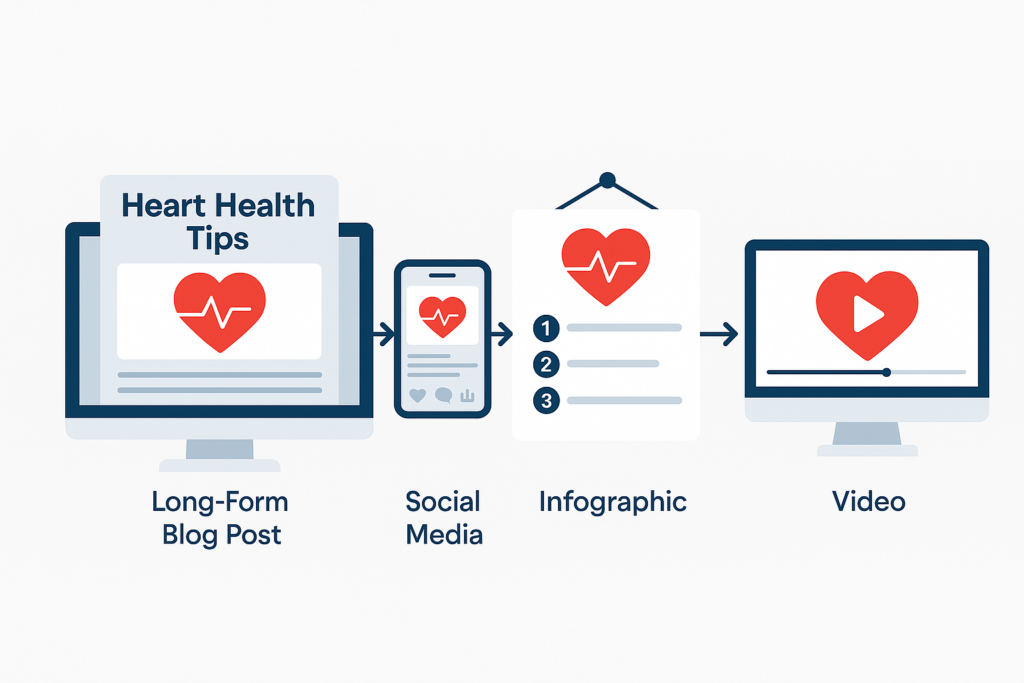
Repurposing also helps you reach patients at different stages of their journey. Some prefer reading detailed guides, while others would rather watch a quick explainer video or scan a checklist.
By diversifying formats, you make your expertise accessible to a wider audience without having to start from scratch each time.
The added benefit is SEO. Publishing content in multiple formats and distributing it across different platforms increases your chances of earning backlinks, driving engagement, and reinforcing your authority on a topic.
Done strategically, repurposing ensures your healthcare content works harder and continues attracting patients long after it’s first published.
Future-Proof Your Healthcare SEO Strategy
Search is evolving rapidly, and healthcare providers can’t afford to treat SEO as static. Google’s AI Overviews and answers from various AI engines are already reshaping how patients discover information.
To stay ahead, focus on creating content that is not only optimized for today’s search results but also structured for tomorrow’s. This means writing concise, authoritative answers that AI tools can easily surface, organizing your content with clear headings, and using structured data to give search engines context.
Voice search is another growing factor, especially for local queries like “urgent care near me open now” or “dentist that takes Blue Cross.”
Optimizing for conversational, natural-language questions will help you capture patients who rely on smart speakers and mobile assistants. At the same time, continue monitoring Google’s algorithm updates, patient search behaviors, and new technologies in healthcare marketing.
By keeping your SEO strategy flexible and forward-looking, you’ll ensure your practice doesn’t just keep up—it leads.
Future-proofing means building a digital presence that adapts with technology, maintains patient trust, and consistently positions your practice as the most reliable choice in your market.
Frequently Asked Questions About Healthcare SEO
What is healthcare SEO?
Healthcare SEO is the process of optimizing your website so patients can find your practice when searching online for medical services, providers, or health information.
Unlike general SEO, it must also meet higher standards of accuracy, trust, and compliance because medical content falls under Google’s Your Money or Your Life (YMYL) category.
Why is healthcare SEO different from regular SEO?
Healthcare SEO has higher stakes. Patients rely on accurate, trustworthy information to make health decisions, and search engines enforce stricter quality standards. In addition to keywords and backlinks, healthcare SEO requires demonstrating medical expertise (E-E-A-T), ensuring HIPAA compliance, and maintaining content accuracy.
How long does it take to see results from healthcare SEO?
SEO is a long-term strategy. While small improvements may show up in weeks, most practices see meaningful growth in traffic and new patient inquiries after 4–6 months.
Results depend on factors like competition, website health, and how consistently you update your content.
Is local SEO really important for healthcare providers?
Yes—most patients search for care close to home. Optimizing your Google Business Profile, keeping your Name, Address, and Phone (NAP) consistent, and creating location-specific landing pages are essential for showing up in local map results and attracting nearby patients.
How do online reviews affect healthcare SEO?
Reviews are critical for both trust and rankings. A steady flow of authentic reviews signals to Google that your practice is reputable, while positive patient feedback reassures new visitors.
Responding to reviews—while staying HIPAA-compliant—strengthens your reputation and can directly influence appointment bookings.
What role does content play in healthcare SEO?
Content is the backbone of SEO. Publishing patient-focused, medically accurate articles, guides, and FAQs helps you rank for more keywords, attract organic traffic, and demonstrate authority in your specialty.
Regular updates also ensure your site reflects the latest medical standards and search engine guidelines.
How can healthcare websites prepare for AI Overviews?
AI Overviews provide patients with summarized answers directly in search results. To prepare, structure your content with clear headings, concise definitions, and schema markup.
Focus on authoritative, patient-friendly content that AI can easily surface when answering health-related queries.
Do small practices really need SEO?
Yes—SEO levels the playing field. Even if you compete with large hospital systems, a well-optimized local SEO strategy can put your practice in front of nearby patients searching for urgent care, specialists, or specific treatments.
Over to You
Healthcare SEO isn’t just about ranking higher—it’s about earning patient trust, protecting privacy, and making your practice the obvious choice when someone searches for care. By focusing on visibility, accuracy, and accessibility, you can connect with patients at the exact moment they need you most.
To get started, take a structured approach:
- Audit your current site to uncover technical issues, outdated content, or gaps in local visibility.
- Fix the foundations by improving site speed, mobile experience, and security.
- Prioritize local SEO by optimizing your Google Business Profile and creating location-specific landing pages.
- Build patient-first content that demonstrates expertise, authority, and trustworthiness.
- Manage reviews and reputation to strengthen both rankings and patient confidence.
- Track and refine continuously so you can adapt to algorithm updates and changes in patient behavior.




